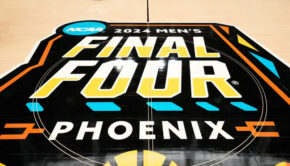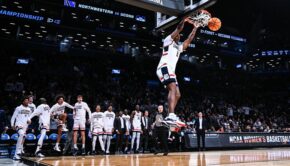Luke Ramsay: Giving it a go
Published on January 21st, 2020
Most Olympic campaigns invest years and years with a mission and a well-paced, systematic plan to try to get on the podium at the Olympic Games. They are not stitched together by two guys with desk jobs, using a boat that’s about 10 years too old, invest three months of winter training before they “give it a go” at the Olympic trials.
But that’s what Canada’s Luke Ramsay and Hunter Lowden are doing, though they are no strangers to the process.
Luke’s highlights include winning the Youth World Championship in the Laser, competing in the 2012 Olympics in a 470 and the 2016 Olympics in a Nacra 17, and earning a pair of Pan Am Silver Medals in the Sunfish in 2015 and 2019.
Hunter Lowden retired from Olympic Class competition after competing at the London 2012 Olympics as crew in the 49er, and has since been director of Sailing at the Royal Vancouver Yacht Club with a mindset to build the sailing programs up to a world class training ground for the next generation, and make their events zero waste.
However, before any Canadian 470 team goes to Tokyo 2020, one of them has to qualify the country, and the last opportunity to earn entry for a North American country is at World Cup Series Miami (January 20-25). In simple terms, one of the three Canadian teams must finish ahead of all three Mexican teams for the single slot.
From there, the results from Miami are combined with the results from the Princess Sofia Regatta in Mallorca in late March. Low combined score goes to the Games… game on!
Scuttlebutt editor Craig Leweck caught up with Luke for an update.
What launched this plan?
I guess it started at the 2019 Pan Am Games when I came back to sail the Sunfish as it reminded me how much I love the sport. I got the bug back which started the thinking of how I might do it, which then led to discussions with my employer. Deciding on the 470, then it was only worth doing if I had the right teammate. For me, I will only sail with people who can bring a lot to the program, and people who have different strengths than me.
A big part of doing this is to learn, and having the right teammate provides that opportunity to play off each other. When Hunter and I first started talking about coming back, we made our list of goals which weren’t typical to what you usually see, which is we want to go medal and kill everybody in the front.
Our goals are 1) Inspire and encourage youth sailors in Vancouver and across Canada to take up the sport of sailboat racing as a lifelong passion; 2) Be leaders and mentors to younger members of the Canadian Sailing Team and Canadian Olympic Team and help put a system in place to pass along knowledge; and 3) Train hard, work smart, and enjoy the grind.
As much as we would like “Win a Gold Medal” to be on this list, we prefer to be realistic and focus on the process in our short 9-month campaign.
Share more about your ‘aha’ moment.
While at the 2019 Pan Ams, taking on more of a leadership role, I realized that a lot of the people on the team didn’t have anything like that, and they were searching for it. So, it was an easy gap to fill because people needed some guidance and someone experienced to fill that role, particularly as coaches can’t always do that because they’re not peers.
Thus far, the most enjoyable aspect has just been learning every day, but also working with the young Canadians and all of the other people on the squad … just helping them out where we can. It’s things you don’t realize that make a big difference. Things that you take for granted but provide an ‘aha’ moment to the newer campaigners.
It’s not that the sport of sailing is so complicated, but rather people don’t ask the fundamental questions and poke at the fundamental things, and so it becomes complicated because you are missing some of the basics. I think it’s easier for an athlete to see when another athlete misses a piece of the puzzle, so that’s what I’m trying to slot in. I am looking for the basic missing parts of the puzzle, and not so much what are the specifics to anyone’s program because I’m not that involved in everyone’s program.
Since Rio you’ve had the chance to enjoy other areas of the sport away from the international spotlight. How has that refreshed your approach and perspective?
I can verify that it’s humbling to do other sailing. After competing at such an elite level, and then going into a different class and getting pounded, you realize how much you still don’t know. But getting your butt kicked is okay, it lights the fire to figure stuff out which is fun, and that’s our approach toward the 470.
We’re are going to try our best but have fun. Without the normal pressure, we aren’t afraid to treat every single day like a learning day and try different things on the water all the time. It can be easier to stay on the wrong path than try a new one, but our approach now is to be more open to change and be less fearful to try new things. We’re less afraid of failure because … what do we have to lose?
How’s it feel getting back in the boat? Any muscle memory kicking in?
For London 2012, I only started sailing the 470 in March 2011, went to the Games in August 2012, and then sold it all and moved on to the Nacra 17 for Rio 2016. Now getting back into the 470 in October 2019, my 470 mileage remains pretty low… less than two years.
So it’s not as if I’ve got a wealth of experience in 470s, but doing a full Olympic campaign in Nacras and doing Lasers for 10 years, it affords you a lot of experience that you can apply across class.
And since the Rio Olympics, you married 470 Olympian Annie Haeger.
Yes, we got married in May of 2018 and she’s been a huge help. She gives us video call debriefs at the end of the day and has been out coaching when we were in Vancouver. Interestingly, when she was doing her Olympic campaign, I was still spending those years thinking about 470s and developed my own ideas and concepts on things.
Now that I am sailing the boat again, it’s been fun as we had a whole bunch of these ‘to do’ items that I had spent four years thinking about and now can try and apply them. How we’re sailing, and what the boat looks like, is dramatically different than the last time I was sailing the 470, and she’s a big part of that.









 We’ll keep your information safe.
We’ll keep your information safe.